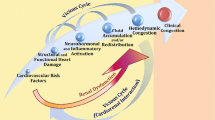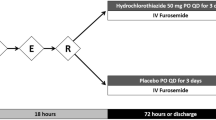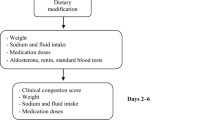Abstract
Congestive heart failure (CHF) worsening is a worldwide cause of rehospitalization and mortality, specially during the early period after hospitalization. Fluid accumulation plays a key role in the pathophysiology of both acute heart decompensation and disease progression. The effective use of drugs to maintain restored clinical stabilization in recently discharged patients is a difficult task, and it relies on matching the most appropriately tailored therapy to specific clinical profiles. However, no successful treatment has been shown to reduce post-discharge readmission. We evaluated in a case-control study the effectiveness of an early and personalized congestion-guided ambulatory program on medium-term (6 months) compensation in recently discharged CHF patients. Group A (22 patients) underwent a post-discharge close follow-up consisting of: an early clinic visit within 10 days; a second visit within 10 days after the first; and the other visits at month 1, 2, 3 after discharge. Controls (Group B, 21 patients) underwent a conventional ambulatory follow-up only at month 1, 2, 3 after discharge. The ambulatory approach in both groups was based on the monitoring of signs/symptoms of congestion and body weight, body hydration estimation by using bioelectrical impedance analysis (BIA) and laboratory data. This assessment was finalized to tailor furosemide and daily fluid intake at each visit to eliminate clinical or instrumental evidence of persistent congestion relieving the signs and symptoms. At 6 months, Group A was associated with a better clinical compensation (improved hydration state, lower BNP levels and congestion score), an improved quality of life, and reduced re-hospitalizations. We conclude that in CHF the early and personalized ambulatory follow-up based on congestion-guided treatment is effective to optimize management and maintain clinical stability in the post-discharge period.




Similar content being viewed by others
References
The Task Force on Acute Heart Failure of the European Society of Cardiology (2005) Executive summary of the guidelines on the diagnosis and treatment of acute heart failure. Eur Heart J26:384–416
Cotter G, Metra M, Milo-Cotter O et al (2008) Fluid overload in acute heart failure: re-distribution and other mechanisms beyond fluid accumulation. Eur J Heart Fail 10:165–169
Parrinello G, Torres D, Paterna S, Di Pasquale P, Licata G (2008) The pathophysiology of acute heart failure: the key role of fluid accumulation. Am Heart J 156:e19
Androne SA, Hryniewicz K, Hudaihed A et al (2004) Relation of unrecognized hypervolemia in chronic heart failure to clinical status, hemodynamics, and patient outcomes. Am J Cardiol 93:1254–1259
Parrinello G, Torres D, Paterna S, Di Pasquale P, Mezzero M, Licata G (2009) The challenge of the volume status assessment in heart failure. Am Heart J 157:e19–e20
Parrinello G, Torres D, Paterna S, Licata G (2009) Is there any novelty on the horizon of heart failure management in internal medicine? The evaluation of body fluid accumulation. Intern Emerg Med 4:269–270
Torres D, Parrinello G, Paterna S, Di Pasquale P, Torres A, Trapanese C, Licata G (2009) A new option in measuring bioimpedance in congestive heart failure. Am Heart J 158:e1
Paterna S, Di Pasquale P, Parrinello G, Fornaciari E, Di Gaudio F, Fasullo S, Giammanco M, Sarullo FM, Licata G (2005) Changes in brain natriuretic peptide levels and bioelectrical impedance measurements after treatment with high-dose furosemide and hypertonic saline solution versus high-dose furosemide alone in refractory congestive heart failure: a double-blind study. J Am Coll Cardiol 45:1997–2003
Piccoli A, Rossi B, Pillon L (1994) A new method for monitoring body fluid variation by bioimpedance analysis: the RXc graph. Kidney Int 46:534–539
Di Lenarda A, Scherillo M, Maggioni AP, Acquarone N, Ambrosio GB, Annicchiarico M, Bellis P, Bellotti P, De Maria R, Lavecchia R, Lucci D, Mathieu G, Opasich C, Porcu M, Tavazzi L, Cafiero M, TEMISTOCLE Investigators (2003) Current presentation and management of heart failure in cardiology and internal medicine hospital units: a tale of two worlds–the TEMISTOCLE study. Am Heart J 146:E12
Fonarow GC, ADHERE Scientific Advisory Committee (2003) The Acute Decompensated Heart Failure National Registry (ADHERE): opportunities to improve care of patients hospitalized with acute decompensated heart failure. Rev Cardiovasc Med 4:S21e30
Neuberg GW, Miller AB, O’Connor CM, Belkin RN, Carson PE, Cropp AB, Frid DJ, Nye RG, Pressler ML, Wertheimer JH, Packer M, PRAISE Investigators (2002) Prospective RandomizedAmlodipineSurvival Evaluation. Diuretic resistance predicts mortality in patients with advanced heart failure. Am Heart J 144:31–38
Gheorghiade M, Filippatos G, Pang PS, et al. (2008) Changes in clinical, neurohormonal, electrolyte, renal, and hepatic profiles during and after hospitalization for acute decompensated heart failure: analysis from the EVEREST trial (late breaking clinical trial). Paper presented at: European Society of Cardiology; September 2, 2008; Munich, Germany
Lucas C, Johnson W, Hamilton MA, Fonarow GC, Woo MA, Flavell CM, Creaser JA, Stevenson LW (2000) Freedom from congestion predicts good survival despite previous class IV symptoms of heart failure. Am Heart J 140:840–847
Valle R, Aspromonte N, Giovinazzo P, Carbonieri E, Chiatto M, Di Tano G, Feola M, Milli M, Fontebasso A, Barro S, Bardellotto S, Milani L (2008) B-type natriuretic peptide-guided treatment for predicting outcome in patients hospitalized in sub-intensive care unit with acute heart failure. J Card Fail 14:219–224
Leendertse AJ, Egberts AC, Stoker LJ, van den Bemt PM, HARM Study Group (2008) Frequency of and risk factors for preventable medication-related hospital admissions in the Netherlands. Arch Intern Med 168:1890–1896
Parrinello G, Torres D, Paterna S, Di Pasquale P, Licata G (2010) Wet BNP, fluid and hemodynamic status at discharge in acute heart failure. Int J Cardiol 19(145):335–336
Khoury DS, Naware M, Siou J, Blomqvist A, Mathuria NS, Wang J, Shih HT, Nagueh SF, Panescu D (2009) Ambulatory monitoring of congestive heart failure by multiple bioelectric impedance vectors. J Am Coll Cardiol 53:1075–1081
Ritzema J, Melton IC, Richards AM, Crozier IG, Frampton C, Doughty RN, Whiting J, Kar S, Eigler N, Krum H, Abraham WT, Troughton RW (2007) Direct left atrial pressure monitoring in ambulatory heart failure patients: initial experience with a new permanent implantable device. Circulation 116:2952–2959
McDonald K (2010) Monitoring fluid status at the outpatient level: the need for more precision. Congest Heart Fail 16(Suppl 1):S52–S55
Paterna S, Parrinello G, Cannizzaro S, Fasullo S, Torres D, Sarullo FM, Di Pasquale P (2009) Medium term effects of different dosage of diuretic, sodium and fluid administration on neurohormonal and clinical outcome in patients with recently compensated heart failure. Am J Cardiol 103:93–102
Parrinello G, Torres D, Paterna S, Di Pasquale P, Licata G (2011) Time to ferry heart failure onto new shores: the need to effectively customize long-term therapy. Am Heart J 161:e13–e14
Nagueh SF (2007) Hemodynamically tailored therapy in congestive heart failure: alive and well. J Card Fail 13:626–628
Metra M, Gheorghiade M, Bonow RO, Dei Cas L (2010) Post-discharge assessment after a heart failure hospitalization: the next step forward. Circulation 122:1782–1785
Piccoli A, Nigrelli S, Caberlotto A, Bottazzo S, Rossi B, Pillon L, Maggiore Q (1995) Bivariate normal values of the bioelectrical impedance vector in adult and elderly populations. Am J Clin Nutr 61:269–270
Conflict of interest
None.
Author information
Authors and Affiliations
Corresponding author
Rights and permissions
About this article
Cite this article
Parrinello, G., Torres, D., Paterna, S. et al. Early and personalized ambulatory follow-up to tailor furosemide and fluid intake according to congestion in post-discharge heart failure. Intern Emerg Med 8, 221–228 (2013). https://doi.org/10.1007/s11739-011-0602-y
Received:
Accepted:
Published:
Issue Date:
DOI: https://doi.org/10.1007/s11739-011-0602-y




